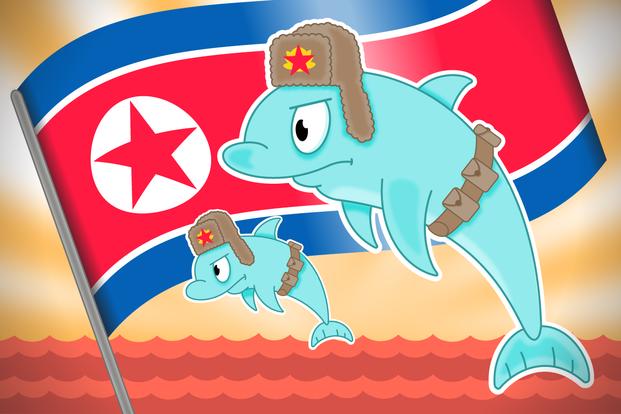Iran and North Korea may have more in common than once thought. They are both members of President George W. Bush's "Axis of Evil," and both have sought nuclear weapons with different degrees of success.
Now, the Democratic People's Republic of Korea (DPRK) may have caught up to the Islamic Republic in one critical area: trained killer dolphins.
Read: Iran May Have a Fleet of Communist Killer Dolphins
A 2000 BBC report alleged that Iran purchased a "fleet" of dolphins from a former Soviet Union dolphin trainer. Those sea creatures were not only trained to seek out underwater mines but also to attack enemy frogmen who infiltrated harbors. The dolphins could also reportedly use suicide tactics to attack enemy ships with explosives.
Now, a new report from the U.S. Naval Institute (USNI) suggests the DPRK is developing wet mammal demolitions (WMD).
Satellite imagery from the North Korean port city of Nampo shows evidence of an animal pen further up the Taedong River. The pens, which have shown up in imagery intelligence since 2015, appear to be perfectly sized for training dolphins.

While dolphins, sea lions and even some whales have been trained for non-combat operations, such as retrieving munitions from the sea floor and elsewhere, it's unlikely a paranoid government like the Kim regime in Pyongyang would use them solely for defense.
The USNI offers that the pens could also be used for fish farming, as North Korea -- a perennially hungry nation -- has ramped up these efforts in recent years. But the location of the pen is also suspect.
Nampo is not only a major naval base for the North but also the location of the West Sea Barrage, which separates the Taedong River from the Yellow Sea -- a dam construction North Korea is very proud of and would want to defend.
If it is true that North Korea is joining the Dolphin Club, which includes the United States, Russia and possibly Iran, it would be the only member of said club that has never deployed them. The U.S. used its cadre of marine allies during the Vietnam War and in the Persian Gulf, while Russia is suspected of having used its in Syria.
While no one is sure why the Russians deployed them in Syria, the United States used its WMD in an anti-swimmer role to keep saboteurs from attaching explosives to its ships and then tagging the divers so they could be captured.
There are currently no known plans in place to discuss anti-dolphin proliferation on the world stage.
-- Blake Stilwell can be reached at blake.stilwell@military.com. He can also be found on Twitter @blakestilwell or on Facebook.
Want to Learn More About Military Life?
Whether you're thinking of joining the military, looking for post-military careers or keeping up with military life and benefits, Military.com has you covered. Subscribe to Military.com to have military news, updates and resources delivered directly to your inbox.





























